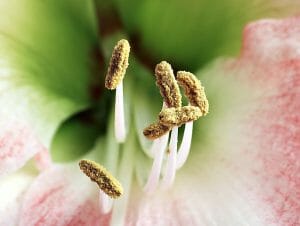Stamen Definition
A stamen is the male reproductive organ of flowering plant species that produces pollen. The stamen is comprised of an anther, which is connected to a filament (pictured below). Within the anther reside the microsporangia, which will ultimately develop into pollen grains. Collectively, the stamens of a flower are termed the androecium, and the number can vary greatly between species. There is also a high level of diversity associated with the position and appearance of the stamens, and depending on the plant species, the stamens may be fused at either the filament or the anther.
Stamen Function
The primary function of the stamen is pollen production. As mentioned above, the anther contains microsporangia within specialized compartments termed pollen sacs. A microsporangium contains a highly nutritious lining housing diploid pollen cells. These diploid cells then undergo meiosis and become haploid spores. After the haploid cells multiply via mitosis, they are termed an immature microgametophyte, or pollen grain. The pollen grains are then released from specialized openings in the anther to facilitate pollination. Pollination occurs by dispersal via the wind, as well as pollinating insects or birds.
Quiz
1. The stamen is comprised of:
A. An anther
B. A filament
C. Microsporangia
D. All of the above
2. Which of the following statements is FALSE regarding the stamen?
A. The primary function of the stamen is pollination.
B. There is a high level of diversity in the appearance and position of the stamen among plant species.
C. The stamen is comprised of an anther and filament.
D. Pollen is produced in the stamen.
References
- Scott et al. (2004). Stamen Structure and Function. The Plant Cell.16(suppl 1). S46-S60.
Stamen

No comments:
Post a Comment